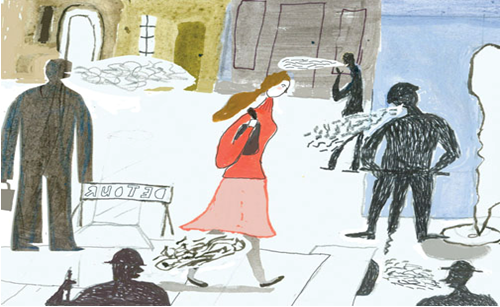One of the first novels to spark my interest in early twentieth-century Spanish women’s literature was Carmen de Burgos’ La rampa (1917). As an urban novel, the narrative explores the effects of modernity not only on the residents of and spaces within Madrid as a metropolitan city, but on the individual women who attempted to navigate – and indeed survive – in this stifling, yet transformative atmosphere. In her novelistic portrayal of life in Madrid, Burgos delves into many themes that were also explored by male authors at this time: the possibilities and challenges of modern spaces; the novelty of places and things we now take for granted; the overwhelming sensation of life moving at an increasingly rapid pace; and the paradoxical new psychology in which the individual feels anonymous and lonely amongst an ever-increasing population of strangers. As an independent woman living and working in Madrid, Burgos paid much more attention to the implications of gender in the city than did her male contemporaries. She specifically dedicated La rampa, for example, to the numerous struggling women who hoped to establish independent, modern lifestyles of their own:
A toda esa multitud de mujeres desvalidas y desorientadas, que han venido a mí, preguntándome qué camino podrían tomar, y me han hecho sentir su tragedia.
To the multitude of defenseless and disoriented women who have come to me, asking me what path they should take, and have made me feel [sorry for] their tragedy.
Originally published in 1917, La rampa contains over 200 pages; you can access the full text as a PDF through Cervantes Virtual. I recently discovered that an abridged version was also published in 1921 – a short 30-page “novela” appearing in the popular literary magazine Los Contemporáneos. I tracked it down and requested a copy via Inter-Library Loan, and I was ecstatic to see that all chapters on Madrid’s Maternity Ward had been included in this second printing. I say “ecstatic” because this is the theme on which I centered my own article, “Maternity Ward Horrors,” (2012) and because literary representations of maternity and motherhood form the bases of my current projects. I’m looking forward to working on an article in the coming weeks that deals specifically with these two different versions of the same novel – especially now that I have worked with my students at length on the shorter novela. It is quite telling to examine which elements of the text were included or discarded in this second addition. Additionally, the contrasting covers suggest on the one hand that the novels may have been marketed to distinct readerships and, on the other hand – if one were to judge a book by its cover – we might surmise (incorrectly) that the subject matter or narrative trajectory would be different:

According to the newest edition of “La rampa” (Stockcero 2006), this cover graced the earliest editions of the novel.

Cover of “La rampa” published in 1921 for the popular literary magazine “Los contemporaneos”. The short length of this version, as well as the affordable price, likely made it quite popular with upper- or even middle-class women.
In my current seminar on 20th century Spanish and Latin American women’s literature, this shorter version of La rampa was the first piece of fiction the class read after having studied various “paradigms of womanhood” that informed female identity in the Hispanic world (the longer version would have taken too long to read at this level). I was quite excited to gain new insights into this novel by discussing it with eighteen young minds that would certainly bring their own unique, often surprising, interpretations and reactions. I have to say – I was not disappointed! I dedicated three class sessions to the novel, and I created reading guides and discussion questions that students prepared prior to each class. I also assigned the class’s first long essay of 700-900 words, or about 3 pages, on this text. This final assignment is what I plan to share in this post (I will also include PDFs of my assignments at the end, just as I did in my previous post on teaching La perfecta casada.
My assignment for the paper was the following (condensed and translated from Spanish):
- Examine the way in which the novel represents different institutions and social expectations targeting modern women. Consider our discussions of traditional paradigms of Spanish womanhood and decide if La rampa re-imagines, criticizes, or reinforces these traditional feminine identities. Are alternative female identities (im)possible?
- This paper must be based on a close literary or textual analysis, not on external research. The thesis should clearly state both the message (criticism) you perceive and the way in which it was successfully (or unsuccessfully) transmitted to readers. I suggest you limit your focus by concentrating on only one theme, such as female labor, motherhood, or marriage.
One additional component of the assignment was to include an image or photograph that students felt represented an aspect of either their paper (thesis) or of the novel or time period in general. I wanted them to be creative with this, as I believe images are extremely powerful in both conveying and affecting our personal interpretations. I always try to incorporate art, or some visual element, into my literature classes. During our final class period working with La rampa, for example, I showed students the two different covers (above) and they offered their thoughts on what each portada might have communicated. Now, as the professor grading all of their papers, I must say I am thoroughly enjoying the creative titles and accompanying images. Somehow, this simple visual addition makes the grading process almost enjoyable. I similarly like to imagine my students eagerly and enthusiastically embarking on the refreshingly “fun,” non-labor intensive task of finding a unique yet pertinent image for the essay they just dedicated so much time to carefully writing and revising (ha!?)… or spending 30 seconds typing their title into “google images”. In any case, this is the first semester I have decided to make the inclusion of an image a requirement on essays (all four of them), and so far I’m happy with the results.
Below are a few of my favorite titles and images – all of them were great, ranging from images of Carmen de Burgos, to different physical “ramps” and staircases representing the metaphorical title, to depictions of stressed-out “modern” women during various decades of the 20th and 21st centuries. If any of you have read La rampa, you will likely appreciate my class’s selections as much as I do – feel free to share your thoughts. If you have not read the text, I’m sure you will still enjoy these title-image juxtapositions… mini works-of-art in and of themselves… Enjoy the “gallery.”

El doble rasero: la perpetuación del maltratamiento de las mujeres en el siglo XX – La rampa (The Double-Standard: The Perpetuation of the Mistreatment of Women in the 20th Century)

El tema de la maternidad y sus realidades como advertencia a las mujeres (The Theme of Maternity and Its Realities as a Warning to Women)
The above is a 1901 painting by Picasso. Somehow in my research on maternity and motherhood during this time period, I had never come across this painting (and if I did, I had never paid it much attention!). So I’m grateful to this student for sharing it. I was curious about this portrait so I did a bit of research googling; I found it on a great site dedicated to images of mothers and breastfeeding in art – Such representations were frequent during the late nineteenth and early twentieth centuries as a means of enticing women to both become mothers and to breastfeed their own children.
[UPDATE: See my more recent post on Picasso’s diverse representations of mothers throughout his career: Picasso on Maternity and Motherhood]
The next images are two of my favorites, simply because they both relate to their titles in relevant ways, and they also really made me smile! And based on these students’ likely search terms… I’m not sure I even want to imagine the resulting “google image” pages.

La mujer: Abarcando la maternidad y la sexualidad en La rampa (Woman: Taking on Maternity [motherhood] and Sexuality in La rampa)

La maternidad y el ciclo de la desigualdad en La rampa (Maternity [motherhood] and the Cycle of Inequality in La rampa)
So now that I have read through the essays and written a “fun” blog post about them – time to get to work on grading! 😦
What “fun” or creative assignment have you given your students? And did they share your sentiments regarding the enjoyable nature of this task?
Resources: Below are PDFs of the assignments I created for “La rampa” – all are in Spanish. The first document contains discussion questions and homework for three, 75-minute classes; The second contains the essay topic and instructions; The third is the print-out with the two different book covers that we used in class.
Homework: La rampa_todas las tareas
Essay: La rampa_Ensayo 1
Cover art: La rampa_covers





















I wish I could take your class, Rebecca! Have you included any of Carmen Martín Gaite’s work in your course syllabus for this semester? Entre visillos is a wonderful criticism of women’s societal roles in Post-Civil War Spain.
Thanks so much for your suggestion and for commenting, Molly. I don’t actually have anything by CMG… mostly because novels like Entre visillos are just too long for this level (I would have to spend way too much time on them). Plus, it was challenging for me to make the syllabus to comply with the Latin American Studies concentration – my area is early 20th century women’s literature, and in Latin America many of the issues I study don’t surface as much in women’s lit until the second half of the 20th century. So it seems I ended up with Spanish texts from early 20th c. and LatAm texts from the later 20th c…. I’m hoping to do a seminar on just Spanish Literature in the future,so I can include postwar and contemporary narratives and trace female ID through the early 20th c to the present… we’ll see!
Pingback: Picasso on Maternity and Motherhood | Rebecca M. Bender, PhD
Pingback: The Red Virgin: Motherhood and Power Dynamics | Rebecca M. Bender, PhD
Pingback: La Llorona: Incorporating Latino Studies into Hispanic Literature | Rebecca M. Bender, PhD
Pingback: Breastfeeding in the Prado: Religious, Mythological, and Pagan Roots | Rebecca M. Bender, PhD
Pingback: “Fun” with Academic Publishing: Wordle, Coffee, and Pedagogy | Rebecca M. Bender, PhD
Pingback: Maternity and Madrid: Gendered Spaces in La rampa (1917) | Rebecca M. Bender, PhD
Pingback: Picasso’s “Guernica” and Aleixandre’s “Oda”: The Spanish Civil War in Art and Poetry | Rebecca M. Bender, PhD
Pingback: Women and the Avant-garde: Maruja Mallo’s “Verbenas” (Carnivals) | Rebecca M. Bender, PhD
Hola Rebecca! My name is Susan Walter, I’m a professor at the U of Denver who specializes in the writings of Emilia Pardo Bazán. I’m currently reading _La rampa_ for the first time, and am considering giving a conference paper on it in the near future. As I was doing some preliminary google searches on the novel your essay came up, along with this wonderful blog. I find all of it very interesting, and sincerely appreciate your generosity in sharing so many materials from your classes. I often teach classes on gender and class in late 19th-century Spain, and have been working more recently on representations of female sexuality in Pardo Bazan’s works, and am intrigued by your treatment of this topic in your class on women and motherhood. An contemporary essay titled “Ni coja ni madre” by Rosa Montero is really interesting if you haven’t read it yet (it doesn’t address sexuality, just societal expectations even in 21st century Spain about women becoming mothers). I found it in the Vista Higher Learning text called REVISTA, but I’d imagine it’s available on-line as well. It would be fun to stay in touch about teaching projects and ideas, you can count on my following your blog posts here. You can find my email easily on the U of Denver website in case you want to get in touch that way (I’m nervous about posting it here).
Hi Susan, Thanks so much for getting in touch! I’ll have to check out Montero’s essay,, I actually haven’t read it yet – I’m always looking for contemporary Spanish texts that deal with the same themes as the early 20th century narratives I research; there are so many similarities in the treatment of gender/sexuality in pre- and post-Francoist Spain yet, unfortunately, the earlier texts are often unknown or overlooked. In terms of teaching LA RAMPA, I’m partial because I love that novel – I have a 2nd article coming out this spring on the “Gendered urban geography” of that novel, and I can send you the final manuscript as soon as I am able, if you’d like (my first article on LA RAMPA was on motherhood and the maternity ward, available via http://www.cromrev.com). In any case, I hope that some of my materials will be useful to you – I always like to see what others do in their classes, which is why I post things here. I’ll definitely be in touch over the next few days via email, and I can pass on other useful teaching materials for the novel or Carmen de Burgos. Likewise, feel free to send me an email at any time if you think of specific questions for the novel or find something you think I should read 🙂 We’ll talk soon!
Hey,
I just wanted to tell you that the link to “my article” doesn’t work anymore, which is a shame because I would really like to read it. I’m writing a paper about the representation of motherhood and Isabela as a mother. Do you have other suggestions where to find information on motherhood in modernity, especially in La Rampa?
Thanks a lot!
Hi Lize, Thanks for pointing that out; you can access the article as a PDF here (http://www.cromrev.com/volumes/vol34/006-vol34-bender.pdf) or via the Cincinnati Romance Review from the following link, it’s called “Maternity Ward Horrors”: http://www.cromrev.com/volumes/vol34/vol34.html
Other than that, you may want to check out Ann Taylor Allen’s “Feminism and Motherhood in Western Europe, The Maternal Dilemma” http://www.palgrave.com/br/book/9781403962362
Good luck!
Pingback: Urban Spain through Literature: Literary Maps of Madrid and Barcelona | Rebecca M. Bender, PhD
Pingback: Multiple Modernities: New essays on Carmen de Burgos (review) | Rebecca M. Bender, PhD